Stayed up late tuesday night working on slides for a half day at google . During the baychi talk, believe it or not, I came up with some changes I wanted to make. Didn’t get home from baychi till about 10:20pm, but was in bed before 1am.
Woke up early enough to get some exercise – I can be super cool presenter dude only if I get plenty of exercise. If I don’t exercise, the whole process of being a speaker isn’t as much fun – but If I exercise, I’m a buddhist monk (as in mellow and smiling deeply) through the whole process.
Scheduled to go on at google at 11am – Arrive early. Way early. 10:15am early. Drove around the outside of campus to see what else was in the neighborhood. I thought the campus looked familiar though I’ve never visited google before… then I saw that tall outdoor sculpture of a man – and realized it was the old Sgi campus!
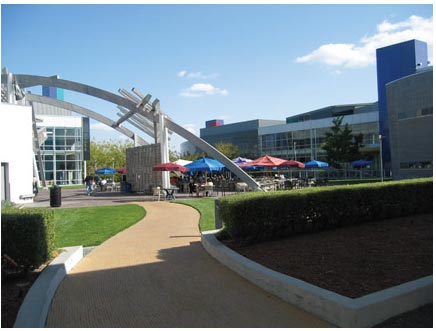 Google campus has the vibe you’d expect – young, smart, and well financed. The architecture is fun. If you believe in the effect environment has on psychology, you’ll love this place. It’s stimulating and open- toys, games, volleyball court – it’s obvious the place is meant to be feel like an adult playground. And inside the buildings is much the same – big spaces, interesting shapes, open workspaces – little of the reptition and monotony found in most office buildings. (At first it reminded me of the blender, a Dr. Seus style incarnation of building A on Microsoft’s redwest campus that was remodeled into a conventional space years ago).
Google campus has the vibe you’d expect – young, smart, and well financed. The architecture is fun. If you believe in the effect environment has on psychology, you’ll love this place. It’s stimulating and open- toys, games, volleyball court – it’s obvious the place is meant to be feel like an adult playground. And inside the buildings is much the same – big spaces, interesting shapes, open workspaces – little of the reptition and monotony found in most office buildings. (At first it reminded me of the blender, a Dr. Seus style incarnation of building A on Microsoft’s redwest campus that was remodeled into a conventional space years ago).
The talk was in a big open room in Building 43 – it felt like being inside a big piece of swiss cheese: the room was nearly triangular, with big holes leading out into other areas. The room has no doors – just two big wide slots for people to enter and leave – I’m pretty sure this was not the room they used to have their top secret uber-private conversations.
Carolyn Yates, my host, was great and showed me around, and got me set up. The tech folks were there and got me set up in 2 minutes. At 11:05, we got started. Had about 100 people there – and more showed up after we started. I remember there being a row of folks standing towards the back.
The talk was a special one – I didn’t do it elsewhere on the tour – it was about stuff I learned while working on web browsers during the first browser war. I talked about managing team size, process and specs not being evil, and the tradeoffs of business, engineering and customers. I think it fit with the issues I guessed Google was dealing with, and the audience responded well. They laughed at jokes, paid attention, and a good crowd stuck around for Q&A. Many of the questions were about Firefox, browser design and strategy, but about half were about project management and development. I should have mentioned that Adam Bosworth, currently a VP at google, was a key player in the early parts of the browser effort – they have a expert on many of these issues in their midsts.
In the afternoon I did a second section with a smaller group of project managers – the safe bet would have been to work from a set presentation, but I went informal – it was only 20 people – and I tried to build up something from questions. I’ve done this dozens of times and its usually more fun for everyone. But this session did not go well – they weren’t happy with it and I wasn’t either. The feedback I got was that more examples from my own experience would have been better – but I was afraid to focus on that as a former Microsoftie speaking on google turf – I thought it’d all be rejected if everything I said came from my war stories. So instead most of the conversation was flat, and never got into good back and forth riffs. ( If you were there, let me know what you thought – I can probably learn something). One question I should have asked, but didn’t, was whether these folks worked together or not – informal/dynamic sessions run much better if it’s an intact team, vs people in the same role in different parts of a organization.
I met several other google folks, and they were all great – asked good questions, were friendly and generous to me – But I didn’t catch nearly enough names, or business cards – a mistake I made many times on this first time solo author tour. If we met and talked, drop me a line.
I left google around 1:30pm – Just enough to time to head back to the hotel for a quick shower and something else to eat, and then off to Yahoo!

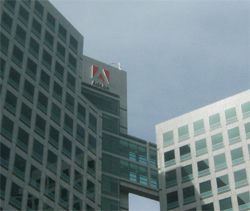 Anyway – Adobe is headquartered in two towers (hmmm) on Park Avenue, San Jose. When I saw them, and the adobe logo on top of the 20th floor, I sad “wow”. By far the biggest most archiectually dominant building I’d seen on the tour.
Anyway – Adobe is headquartered in two towers (hmmm) on Park Avenue, San Jose. When I saw them, and the adobe logo on top of the 20th floor, I sad “wow”. By far the biggest most archiectually dominant building I’d seen on the tour.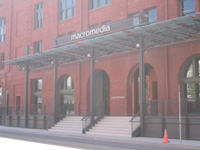 I had thought I’d get up early Thursday morning, stop by Google and retrieve the cable, but the lack of anything resembling power in the battery of my car made this impossible. Tip: the extra money for hertz is worth it. They had a service person there to give me a jump in about 45 minutes (btw: the Sheraton folks refused to help – “against policy”. To jumpstart a car? They have a policy for that?)
I had thought I’d get up early Thursday morning, stop by Google and retrieve the cable, but the lack of anything resembling power in the battery of my car made this impossible. Tip: the extra money for hertz is worth it. They had a service person there to give me a jump in about 45 minutes (btw: the Sheraton folks refused to help – “against policy”. To jumpstart a car? They have a policy for that?)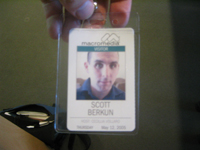
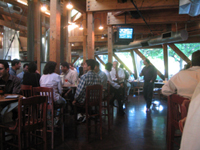 About 12 people showed over the course of a few hours. Given I’d never met most of these people before, I was pleased. None of them tried to sell me Amway goods or convince me that the end was near. The conversation and beer was good. I’d definitely do something like this again next time.
About 12 people showed over the course of a few hours. Given I’d never met most of these people before, I was pleased. None of them tried to sell me Amway goods or convince me that the end was near. The conversation and beer was good. I’d definitely do something like this again next time.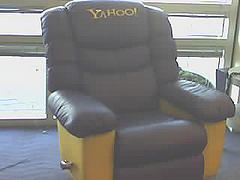 I arrived at Yahoo’s building D at 3:30 – right on time for my 4pm talk. Everything inside was wonderfully purple and yellow, including the big oversized comfy recliner in the waiting area. I explored the Yahoo store in the lobby, looking for a pair of purple and yellow boxers, while waiting for my host
I arrived at Yahoo’s building D at 3:30 – right on time for my 4pm talk. Everything inside was wonderfully purple and yellow, including the big oversized comfy recliner in the waiting area. I explored the Yahoo store in the lobby, looking for a pair of purple and yellow boxers, while waiting for my host  Google campus has the vibe you’d expect – young, smart, and well financed. The architecture is fun. If you believe in the effect environment has on psychology, you’ll love this place. It’s stimulating and open- toys, games, volleyball court – it’s obvious the place is meant to be feel like an adult playground. And inside the buildings is much the same – big spaces, interesting shapes, open workspaces – little of the reptition and monotony found in most office buildings. (At first it reminded me of the blender, a Dr. Seus style incarnation of building A on Microsoft’s redwest campus that was remodeled into a conventional space years ago).
Google campus has the vibe you’d expect – young, smart, and well financed. The architecture is fun. If you believe in the effect environment has on psychology, you’ll love this place. It’s stimulating and open- toys, games, volleyball court – it’s obvious the place is meant to be feel like an adult playground. And inside the buildings is much the same – big spaces, interesting shapes, open workspaces – little of the reptition and monotony found in most office buildings. (At first it reminded me of the blender, a Dr. Seus style incarnation of building A on Microsoft’s redwest campus that was remodeled into a conventional space years ago).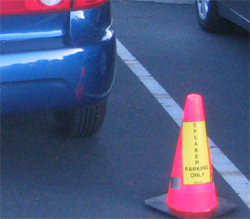 I gave out about 15 books to folks that asked questions – which i learned was the smart way to use the promotional copies I had (a tip for any future book tour planners out there) – it got people to stay, and it got them to participate, and gave the vibe of everyone being interested in what I had to say.
I gave out about 15 books to folks that asked questions – which i learned was the smart way to use the promotional copies I had (a tip for any future book tour planners out there) – it got people to stay, and it got them to participate, and gave the vibe of everyone being interested in what I had to say. 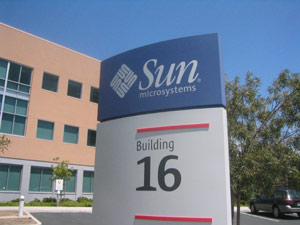 At the talk we had about 40 people show up, plus another 15 or more on conference call.
At the talk we had about 40 people show up, plus another 15 or more on conference call.